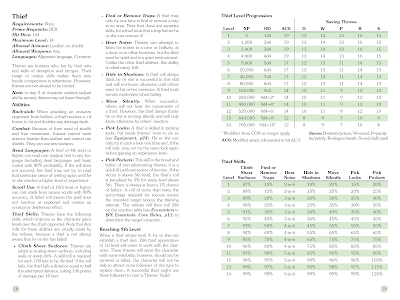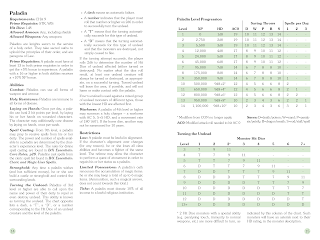On the B/X-ification of Classes
As part of the work on the future B/X Essentials: Advanced Characters book (previously mentioned here), I've found myself reading a lot of AD&D material. With my general B/X obsession, AD&D isn't something I've looked at in great depth for quite some years, so it's been very interesting to observe the contrast between the two rules sets. On the surface, just reading through the class descriptions, the rules are, for the most part, the same, and the level of complexity doesn't seem so much greater. It was when I came to directly comparing the AD&D classes against the B/X classes, though, that the differences stood out rather sharply.
Principles
My aim with the Advanced Characters book is not merely to clone the AD&D material, but to present classes that slot cleanly into B/X. This has several aspects:
Rules: Obviously, the classes must not use any rules that only exist in AD&D (good and evil alignment, for instance). Complexity: The classes must not be any more complex than the existing B/X classes, in terms of the number of class abilities or the mechanical complexity of those abilities. Power: Generally, AD&D amps things up from B/X. The majority of classes have higher HD. Some classes start play with multiple HD. I want my converted classes to be in line with B/X power levels. Rarity: In AD&D, some classes are clearly way more powerful than others. The paladin is a prime example: unlimited use of detect evil, and a continually active protection from evil, 10' radius are the most obvious super-powered class abilities (and both from 1st level!). In order to make classes like this less commonplace, AD&D introduces an additional mechanism: stringent ability score requirements. Only with super lucky rolls can a player select the paladin class, making them exceedingly rare. (This, in turn, was the genesis of the "alternative rolling methods" arms race. But that's another topic.) This concept of class power vs rarity doesn't exist in B/X to anywhere near the same level (the most stringent class requirements are the halfling's CON 9, DEX 9 -- hardly a harsh limitation), so my converted classes should not rely on it. Overlap: Each class should have a clear niche, and its own set of unique abilities. The core B/X classes (especially the core 4 human classes) each have a very clearly defined niche, and can do things that other classes cannot. Adding more classes to the mix, a degree of overlap is inevitably going to creep in, but my aim is to keep this to a minimum, and to make sure that each class retains a niche. There's a tendency in AD&D classes to be able to do everything another class can do, plus X, Y, Z. I want to avoid this.
Practice
With the above in mind, I started writing up some B/X-ified versions of AD&D classes. The question was, though, what exact yardstick to use to ensure that I was achieving the goals I'd set? Eyeballing and play testing are, of course, necessary, but to address the points of complexity and overlap, I quickly came upon a very different, rather unusual, and highly effective method.
One of the prime directives of B/X Essentials is that (as far as possible) all material relating to a topic should appear on the same page or spread. Thus, a very effective measure of the rules-complexity of a topic is simply: how much space does it take up when laid out?
In the basic Classes and Equipment book, the class descriptions have all been painstakingly edited and laid out to fit exactly onto a single page or spread each. For example, the most complex B/X classes (according to the "how much space?" definition of complexity):
 The cleric class -- turn undead requires a lot of explanation
The cleric class -- turn undead requires a lot of explanation
 The thief class -- there's a lot of those % skillsSo, if it's possible to fit the whole description of every B/X class onto a single 6" x 9" spread, including all required tables, it should also be possible to fit any new, additional classes within the same space constraints. It was when I started to attempt this that I truly realised how much complexity there is in some of the AD&D classes! Some of them required a huge amount of trimming. But this process of trimming to fit on a spread forced me to consider two things:
The thief class -- there's a lot of those % skillsSo, if it's possible to fit the whole description of every B/X class onto a single 6" x 9" spread, including all required tables, it should also be possible to fit any new, additional classes within the same space constraints. It was when I started to attempt this that I truly realised how much complexity there is in some of the AD&D classes! Some of them required a huge amount of trimming. But this process of trimming to fit on a spread forced me to consider two things:
Which abilities can be simplified? (i.e. so that explaining them takes less words and/or tables.)Which abilities are really the core of this class, and which can be removed?ResultsThus, my aims of complexity and overlap were neatly addressed by this process of rough layout. As a result, I think the classes I'm coming up with are much closer to true B/X-ifications of AD&D material than other, previous attempts at this.
As an example, here's a laid out preview of my B/X-ified paladin class:

I'll be putting out an official call for play testers soon, but if anyone has any feedback on the paladin, please feel free to comment!
Principles
My aim with the Advanced Characters book is not merely to clone the AD&D material, but to present classes that slot cleanly into B/X. This has several aspects:
Rules: Obviously, the classes must not use any rules that only exist in AD&D (good and evil alignment, for instance). Complexity: The classes must not be any more complex than the existing B/X classes, in terms of the number of class abilities or the mechanical complexity of those abilities. Power: Generally, AD&D amps things up from B/X. The majority of classes have higher HD. Some classes start play with multiple HD. I want my converted classes to be in line with B/X power levels. Rarity: In AD&D, some classes are clearly way more powerful than others. The paladin is a prime example: unlimited use of detect evil, and a continually active protection from evil, 10' radius are the most obvious super-powered class abilities (and both from 1st level!). In order to make classes like this less commonplace, AD&D introduces an additional mechanism: stringent ability score requirements. Only with super lucky rolls can a player select the paladin class, making them exceedingly rare. (This, in turn, was the genesis of the "alternative rolling methods" arms race. But that's another topic.) This concept of class power vs rarity doesn't exist in B/X to anywhere near the same level (the most stringent class requirements are the halfling's CON 9, DEX 9 -- hardly a harsh limitation), so my converted classes should not rely on it. Overlap: Each class should have a clear niche, and its own set of unique abilities. The core B/X classes (especially the core 4 human classes) each have a very clearly defined niche, and can do things that other classes cannot. Adding more classes to the mix, a degree of overlap is inevitably going to creep in, but my aim is to keep this to a minimum, and to make sure that each class retains a niche. There's a tendency in AD&D classes to be able to do everything another class can do, plus X, Y, Z. I want to avoid this.
Practice
With the above in mind, I started writing up some B/X-ified versions of AD&D classes. The question was, though, what exact yardstick to use to ensure that I was achieving the goals I'd set? Eyeballing and play testing are, of course, necessary, but to address the points of complexity and overlap, I quickly came upon a very different, rather unusual, and highly effective method.
One of the prime directives of B/X Essentials is that (as far as possible) all material relating to a topic should appear on the same page or spread. Thus, a very effective measure of the rules-complexity of a topic is simply: how much space does it take up when laid out?
In the basic Classes and Equipment book, the class descriptions have all been painstakingly edited and laid out to fit exactly onto a single page or spread each. For example, the most complex B/X classes (according to the "how much space?" definition of complexity):
 The cleric class -- turn undead requires a lot of explanation
The cleric class -- turn undead requires a lot of explanation The thief class -- there's a lot of those % skillsSo, if it's possible to fit the whole description of every B/X class onto a single 6" x 9" spread, including all required tables, it should also be possible to fit any new, additional classes within the same space constraints. It was when I started to attempt this that I truly realised how much complexity there is in some of the AD&D classes! Some of them required a huge amount of trimming. But this process of trimming to fit on a spread forced me to consider two things:
The thief class -- there's a lot of those % skillsSo, if it's possible to fit the whole description of every B/X class onto a single 6" x 9" spread, including all required tables, it should also be possible to fit any new, additional classes within the same space constraints. It was when I started to attempt this that I truly realised how much complexity there is in some of the AD&D classes! Some of them required a huge amount of trimming. But this process of trimming to fit on a spread forced me to consider two things:Which abilities can be simplified? (i.e. so that explaining them takes less words and/or tables.)Which abilities are really the core of this class, and which can be removed?ResultsThus, my aims of complexity and overlap were neatly addressed by this process of rough layout. As a result, I think the classes I'm coming up with are much closer to true B/X-ifications of AD&D material than other, previous attempts at this.
As an example, here's a laid out preview of my B/X-ified paladin class:

I'll be putting out an official call for play testers soon, but if anyone has any feedback on the paladin, please feel free to comment!
Published on August 02, 2018 22:33
No comments have been added yet.
Gavin Norman's Blog
- Gavin Norman's profile
- 32 followers
Gavin Norman isn't a Goodreads Author
(yet),
but they
do have a blog,
so here are some recent posts imported from
their feed.



